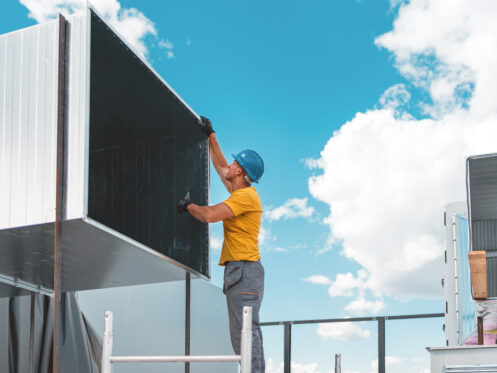A company’s success in Las Vegas, NV depends heavily on the comfort of its employees. And the comfort of employees depends significantly on the company’s commercial HVAC systems. This is because temperature control in the office directly affects the productivity of personnel. Fortunately, commercial property owners have more choices than ever before when it comes to HVAC system options. And there are more than a few good reasons to make 2024 the year that you implement these upgrades.
1. Reduced Heating and Cooling Expenses
Commercial HVAC system upgrades are an excellent long-term investment due to the significant energy savings they provide. In fact, businesses can save as much as 40% or more on energy expenses by installing a new HVAC system. To maximize performance, modern systems include cutting-edge technology, such as energy-efficient components and variable-speed motor options. When paired with improved ventilation, smart thermostats and insulation, a new HVAC system synergistically creates a comprehensive and energy-efficient ecosystem within commercial spaces. Some upgrades even allow you to make precise temperature adjustments in response to occupancy and use patterns. As a whole, these renovations cut down on energy use, which reduces power costs.
2. Enjoy a Reduced Environmental Impact
Commercial HVAC system upgrades that use energy-efficient technology can reduce carbon emissions. A smaller carbon footprint is a sign of corporate responsibility and a way for businesses to satisfy the expectations of eco-conscious consumers. Moreover, some businesses qualify for special grants and loans dedicated to supporting environmentally friendly initiatives; this provides additional financial incentives for making eco-conscious upgrades. This dual benefit of environmental stewardship and potential financial support makes investing in energy-efficient HVAC technology a strategic and responsible choice for businesses.
3. Experience Less Downtime
HVAC breakdowns create unpleasant interior conditions. This can have a detrimental effect on staff morale, customer satisfaction and the company’s brand. Incorporating smart thermostats, energy-efficient technologies and sophisticated controls safeguards HVAC systems against unexpected failures. They do this by helping the systems use as little energy as possible when heating and cooling. This results in less wear and tear on system parts. Predictive analytics and routine commercial maintenance work together to further minimize unexpected malfunctions and downtime.
4. Install VRF Systems
By regulating individual zones with pinpoint accuracy, variable refrigerant flow (VRF) technology allows you to maximize efficiency and comfort throughout the entire office. These systems are adaptable, meaning they can fit a variety of space requirements and user preferences. This makes them especially ideal for open-office layouts or buildings with diverse occupancy needs. Vertical regenerative heat pumps (VRFs) work well for space heating and cooling in multi-story buildings. They are commonly installed in vertical configurations, utilizing the building’s height for efficient heat exchange.
5. Use Demand-Controlled Ventilation
Demand-controlled ventilation (DCV) is a method for controlling ventilation rates in HVAC systems. It does this by monitoring the indoor air quality and the actual occupancy levels of a room. By adjusting the flow of fresh air in response to actual demand, DCV maximizes energy efficiency, which is helpful for commercial premises. In order to adjust the ventilation rates based on occupancy and air quality, the system uses sensors to keep tabs on both. During times of low occupancy, this not only improves the air quality inside but also decreases the amount of energy used. For commercial areas with unpredictable occupancy levels, DCV is a lifesaver when it comes to long-term cost savings, comfort and effective ventilation.
6. Integrate With Building Automation Systems
With building automation systems, you can enhance energy efficiency by synchronizing systems like HVAC, lighting and security. Predictive maintenance features reduce downtime, while automated adjustments to changing circumstances increase comfort. Analytics and data collected in real-time allow for proactive energy management, which in turn reveals energy-saving opportunities. By addressing these opportunities, it’s possible to save a considerable amount of money on energy costs.
7. Use High-Efficiency Chillers
There are two types of chillers: those that use water to disperse heat and those that use air to do the same. Their high-efficiency compressors boost performance while cutting down on power use. Because of their adaptability, they can efficiently and dependably regulate temperatures in a wide range of commercial applications. Office buildings commonly use them to maintain a comfortable and productive environment. Hospitals use them to achieve precise temperature control for two main purposes: better patient comfort and enhanced functioning of medical equipment. Industrial settings use them to prevent machinery from overheating. In data centers, chillers maintain a regular temperature to preserve the functioning of servers and electronic equipment.
8. Install Heat Recovery Ventilation Systems
A heat recovery ventilator (HRV) system improves the air inside a building by transferring heat from the outside air to the inside air and back again. This is essential to maximizing energy efficiency in commercial settings. Enthalpy recovery ventilators (ERVs) and heat recovery ventilators (HRVs) are the two main categories of energy recovery ventilation systems. ERVs are the most popular for commercial settings. In both types, a heat exchanger transfers heat from the entering air to the exiting air.
9. Upgrade to Solar HVAC Systems
Solar technologies aim to improve comfort and air quality while reducing energy use. Commercial HVAC systems that work with solar technologies include air conditioning systems, heaters, water heaters and ventilation systems. Solar thermal collectors collect solar thermal energy to supplement space heating and hot water needs in HVAC applications. This is particularly helpful for heating, ventilation and air conditioning systems that rely on water heating. Such systems include water-source heat pump systems, radiant floor heating systems, chilled beam systems and hydronic heating systems.
10. Use Advanced Air Filtration Systems
By efficiently catching and neutralizing airborne pollutants, advanced air filtration systems improve indoor air quality using HEPA filters and UV-C technology. These systems are vital for workers’ health and wellbeing because they lessen the likelihood of respiratory problems and illness in the office. Better air quality also makes people feel more at ease and increases productivity, which is great for employee satisfaction and overall business performance.
11. Take Advantage of Thermal Energy Storage
Thermal energy storage (TES) is a game-changing method that improves commercial HVAC systems by storing excess energy during off-peak hours. Using TES to shift energy use to off-peak hours, when rates are typically lower, can help businesses save money on their monthly power costs. This not only reduces operational costs but also increases grid efficiency. There are three main types of thermal energy storage options: ice, chilled water and molten salt. Offices, malls and schools are some examples of commercial facilities with variable cooling needs that are ideal candidates for ice thermal energy storage. Facilities like data centers, hospitals and factories that need constant chilling are ideal for chilled water thermal energy storage. Concentrated solar power plants and industrial settings frequently employ molten salt thermal energy storage.
Bumble Breeze is here to meet all of your commercial HVAC, plumbing and indoor air quality needs. Give us a call today to learn more about commercial HVAC upgrades to make in 2024.


